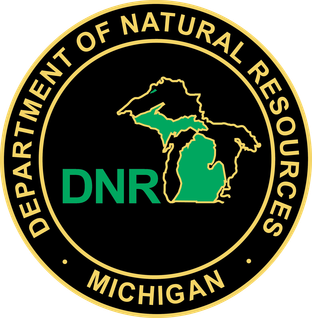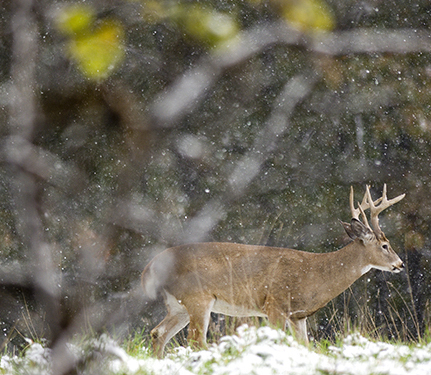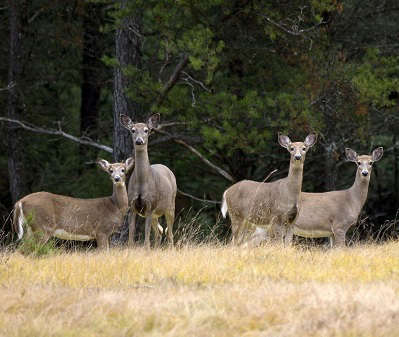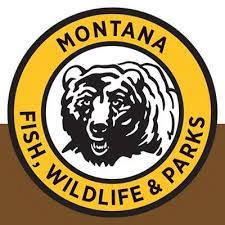Michigan’s Firearm deer hunting begins Nov. 15
Join in the time-honored tradition of deer hunting in Michigan. Get ready for a terrific time in Michigan’s beautiful forests and fields. Firearm deer season is open Nov. 15-30.
-
- Deer season forecast
- Report your deer harvest online
- Find regulations in the 2024 Deer Hunting Regulations Summary
- Important firearm deer season reminders
- Safety is key to every successful hunt
- Doe your part! Harvest an antlerless deer
- Support your community, donate a deer
- Will EHD affect your deer season?
- CWD and TB testing at deer check stations
- Purchase your deer patch
- Questions? Contact us
Deer season forecast
Prepare for your season by reading about how things are shaping up in your neck of the woods in the 2024 deer season forecast.
|
|
Report your deer harvest online
Online harvest reporting is required for all hunters who successfully take a deer. You can report your deer through the DNR Hunt Fish app or at Michigan.gov/DNRHarvestReport.
Reporting your harvest gives us a real-time snapshot of how the season is going. Check out harvest totals across the state in the reporting dashboard.
|
|
Find regulations in the 2024 Deer Hunting Regulations Summary
Be sure to check the latest hunting regulations in your area by looking at the 2024 Deer Hunting Regulations Summary. For on-demand access to this info that travels where you do, without the need for internet access, download the Michigan DNR Hunt Fish app.
|
|
Important firearm deer season reminders
-
-
- Open statewide on public or private lands.
-
- Deer hunters in the Lower Peninsula have the option to harvest antlerless deer with their deer or deer combo license.
- A three-point APR was reinstated in Deer Management Unit 122 on the single deer license in the Upper Peninsula.
- Antlerless deer hunting access permit quotas were reduced in DMU 351 from 1,000 to 0 and in DMU 352 from 1,000 to 500 in the Upper Peninsula.
-
Safety is key to every successful hunt
With Michigan’s firearm deer season starting Friday, the DNR reminds everyone to put safety first. This brief video offers safety highlights.
Lt. Tom Wanless, who heads the DNR’s recreational safety, education and enforcement section, said that although some tips seem like common sense, it’s critical for anyone hunting with firearms to consider safety basics.
“Success is not always about filling your tag, it’s about safely enjoying the experience and sharing it with friends and family after the hunt,” Wanless said.
All firearm deer hunters should:
-
-
- Treat every firearm as if it is loaded.
- Be aware of your surroundings – know your target and what is beyond it.
- Unload firearms when crossing obstacles and/or getting in or out of an elevated stand.
- Obey “no trespassing” signs; they are there for a reason.
- Obtain landowner permission to retrieve game that has wandered onto private property.
- Wear “hunter orange” to increase your visibility to other hunters. Hunter orange garments must be worn as the outer layer of clothing (such as caps, hats, vests or jackets) and must be visible from all directions.
-
During the firearm deer season, all hunters and nonhunters are encouraged to wear bright colors, especially hunter orange, when recreating near woods or fields where hunting may occur.
Get more hunting and tree stand safety tips at Michigan.gov/HuntingSafety, and season and regulation details in the 2024 Deer Hunting Regulations Summary.
Questions about safety? Email DNR-LED-RecSafety@Michigan.gov.
|
|
Doe your part! Harvest an antlerless deer
Many areas in Michigan’s Lower Peninsula have too many deer. This overpopulation can cause problems for people, such as more vehicle collisions, damage to crops and gardens, and the spread of wildlife diseases where they exist.
New hunting regulations have been put in place, designed to encourage hunters to harvest more antlerless deer. Hunters play a critical role in helping to manage deer numbers, which is important to protect public safety, reduce property damage and limit disease spread.
If you’re hunting in an area with high deer numbers or an area where chronic wasting disease or bovine tuberculosis are present, consider taking a doe this year to do your part in managing Michigan’s deer herd.
Purchase a universal antlerless license for $20 online at eLicense, through the DNR Hunt Fish app or anywhere DNR licenses are sold.
|
|
Support your community, donate a deer
Join us this deer season to help feed Michigan communities through our wild game donation program! There will be several events held this fall to collect harvested deer for donation to food pantries.
Jay’s Sporting Goods, Clare
-
-
- Nov. 16: 10 a.m. to 4 p.m.
- Nov. 17: 11 a.m. to 4 p.m.
- Nov. 23: 10 a.m. to 4 p.m.
- Nov. 24: 11 a.m. to 4 p.m.
-
Frank’s Great Outdoors, Linwood
-
-
- Nov. 16: 10 a.m. to 4 p.m.
- Nov. 17: 11 a.m. to 4 p.m.
-
Knutson’s Sporting Goods, Brooklyn (NEW)
-
-
- Jan. 4: 10 a.m. to 4 p.m.
- Jan. 5: 11 a.m. to 4 p.m.
-
Want to keep your deer but still give back? Consider donating to the program when buying your license or making an online donation. All donations help process and distribute venison to those in need across Michigan.
|
|
Will EHD affect your deer season?
Epizootic hemorrhagic disease, or EHD, has been confirmed in wild deer across 15 counties in southern Michigan, including Allegan, Barry, Berrien, Branch, Calhoun, Cass, Genesee, Jackson, Hillsdale, Kalamazoo, Kent, Lenawee, Ottawa, St. Joseph, and Van Buren. Based on reported data and pending test results, the virus has likely been present in several other counites as well.
Since first detection in late July, over 4,300 suspected cases have been reported. EHD spreads through bites from midges, which die off after the season’s first hard frost. Reports of new EHD cases have slowed drastically since mid-October, as recent frost has reduced midge activity.
Though this viral disease can cause high deer mortality, the impact tends to be localized, with some areas seeing heavy losses while nearby areas show no effects.
Most hunters won’t need to change their harvest plans and should still target antlerless deer. However, some hunters in areas that were highly affected by EHD may consider modifying their harvest plans to reduce hunting pressure while the deer population recovers. After a widespread EHD outbreak in 2012, local herds showed signs of rebounding after just a couple of years and were fully recovered after four to five years.
As always, hunting plans are up to the hunter’s discretion. For those considering moving to a new hunting location this fall, there are ample opportunities for public land hunting across the state. Find new locations through Mi-Hunt or check out a state game/wildlife area or Hunting Access Program properties.
|
|
CWD and TB testing at deer check stations
This year, chronic wasting disease testing will still be focused in some areas of the northern Lower Peninsula as well as the Upper Peninsula. The counties for CWD testing in 2024 include Antrim, Arenac, Baraga, Benzie, Cheboygan, Chippewa, Clare, Dickinson, Gladwin, Grand Traverse, Houghton, Iosco, Kalkaska, Keweenaw, Leelanau, Luce, Mackinac, Manistee, Ogemaw, Ontonagon, Otsego and Schoolcraft.
Testing your harvested deer is crucial for monitoring and managing CWD’s spread. Testing options currently available in 2024 include:
-
-
- Drop the head off: Drop off your deer head at drop box, staffed station or cooperating taxidermist or processor. Find a list of submission locations.
- Self-sample kits: Kits are available in Clinton, Eaton, Gogebic, Gratiot, Hillsdale, Ingham, Ionia, Iron, Isabella, Jackson, Kent, Menominee, Midland and Montcalm counties. Kits can be picked up from the locations listed on the CWD testing page. Hunters should call the office prior to arriving to ensure someone will be available to assist.
- Sample testing for a fee: Deer harvested in counties that are not eligible for free CWD testing can be submitted to Michigan State University Diagnostic Laboratory or Wisconsin Veterinary Diagnostic Laboratory.
-
Focused monitoring for bovine tuberculosis is occurring in Alcona, Alpena, Cheboygan, Crawford, Iosco, Montmorency, Ogemaw, Oscoda, Otsego, Presque Isle and Roscommon counties, though deer also can be turned in for TB testing from anywhere in the state at a hunter’s request.
To submit your deer for TB testing, take it to a DNR staffed deer check station, drop box, or cooperating processor or taxidermist. Report your harvest and remove deer heads prior to visiting a sample submission site. Learn more on the bovine tuberculosis testing page.
|
|
Purchase your deer patch
You can now purchase a successful hunter deer patch for $8 through the Michigan DNR Licenses & Permits eLicense store. Click on the “Purchase a license, permit, and application, or reprint your license” tile, log in and select the “Patches” tab to order.
|
|
Questions? Contact us
Contact the DNR Wildlife Division at 517-284-9453.





